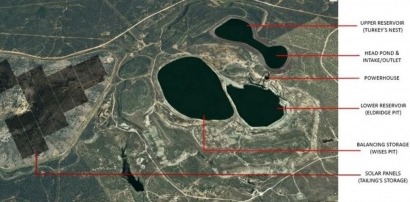
The hub, located in Kidston in Northern Queensland, will comprise three renewable energy projects: a 50 MW solar project (Kidston Solar Project Phase One 50 MW, or KSP1); a 250 MW pumped-storage hydro project (Kidston Pumped Storage Hydro Project, or KPSHP) and an additional 270 MW solar project (Kidston Solar Project Phase Two 270 MW, or KSP2).
The Kidston Gold Mine, once the largest open-cut gold mine in Australia, was closed in 2001. The mine provides a number of infrastructure pieces Genex Power will use as part of the renewable energy hub, including two large mining voids filled with significant volumes of water, a tailings storage facility, a waste rock dump, an existing transmission line and substation, an airport strip and existing road access to the site.
Construction of KSP1 began in January of this year. When completed it is expected to produce 145,000 MWh of energy per year, or enough to power 26,484 homes.
Pumped storage hydro is a form of energy storage where water is held at elevation and released down into a lower reservoir, passing through turbines and generators that produce electricity. Once the water has filled the lower reservoir, it is pumped back via reversible pump/generators to the upper reservoir. The KPSHP will utilize existing infrastructure from the abandoned mine, with two mining voids acting as integral features of the closed-loop design.
When completed, KPSHP will have a generation capacity of 250 MW. Construction on this portion of the hub is expected to begin in 2018 with first generation expected in 2021.
The final portion of the hub, KSP2, will consist of a 270 MW solar farm co-located with the KSP1 and the KPSHP. This solar farm will be used to power the pumped storage hydro project during the ‘pumping mode’ (where water is transported back up to the upper reservoir). Integrating these two projects will mitigate significant risk in terms of reliance on grid power and volatility associated with energy prices. Construction on KSP2 is anticipated to begin in 2018.
The project also includes a 115 mile transmission line to carry power to the coast and the main Powerlink line between Townsville and Cairns.
The hub is anticipated to aid the government in reaching its goal of 50% of Queensland’s power needs being met by renewable energy by 2030.
For additional information:

